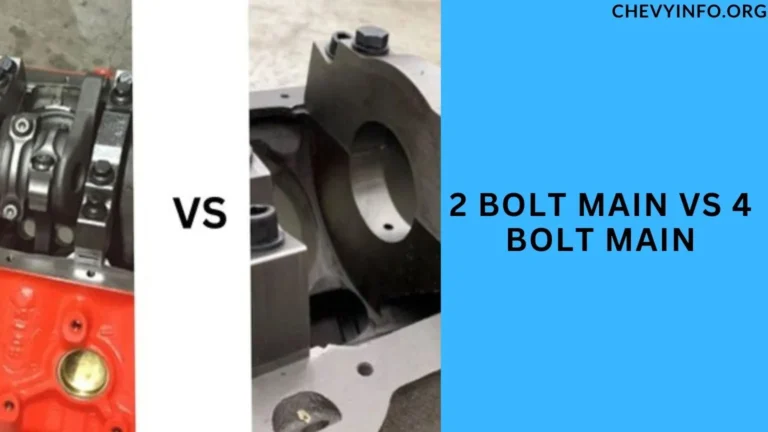How to Disengage 4 Wheel Drive Chevy Silverado? (Guide) 2024
How to Disengage 4 Wheel Drive Chevy Silverado? If you’re a proud owner of a Chevy Silverado equipped with 4 Wheel Drive (4WD),
knowing how to disengage it properly can enhance your driving experience and prevent unnecessary wear and tear on your vehicle.
Whether you’re transitioning from off-road terrain to regular roads or simply want to optimize fuel efficiency, understanding the disengagement process is crucial.
This guide will walk you through the steps to disengage 4WD in your Chevy Silverado effectively.

Introduction to 4 Wheel Drive (4WD)
4 Wheel Drive (4WD) is a system commonly found in trucks and SUVs, including the popular Chevy Silverado.
It allows the vehicle to distribute power to all four wheels simultaneously, providing enhanced traction and stability, especially in off-road or slippery conditions.
Understanding the Functioning of 4WD in Chevy Silverado
Before diving into the disengagement process, it’s essential to understand how 4WD works in your Chevy Silverado.
When engaged, power is sent to both the front and rear axles, allowing for optimal grip and performance in challenging terrains.
However, for regular driving on paved roads, disengaging 4WD can improve fuel efficiency and reduce unnecessary strain on the drivetrain.
Steps to Disengage 4WD in Chevy Silverado

Follow these steps to seamlessly switch from 4WD to 2WD mode in your Chevy Silverado:
Step 1: Bring Your Vehicle to a Stop
Ensure your Chevy Silverado is completely stationary before attempting to disengage 4WD. This prevents any potential damage to the drivetrain and ensures a smooth transition.
Step 2: Shift the Transmission to Neutral
Move the transmission gear selector to the neutral position. This step is crucial as it allows the drivetrain components to disengage smoothly.
Step 3: Turn the 4WD Selector Switch to 2WD
Locate the 4WD selector switch in your Chevy Silverado. Depending on the model year and trim level, this switch may be manual or electronic.
Turn the switch to the 2WD mode, indicating that you want to disengage 4WD and operate in two-wheel drive mode.
Step 4: Engage the Vehicle Back in Gear
Once you’ve successfully switched to 2WD mode, engage the transmission back into gear. You can now resume driving your Chevy Silverado in regular two-wheel drive mode, optimizing fuel efficiency and handling for on-road conditions.
Common Issues and Troubleshooting Tips
While disengaging 4WD is generally straightforward, some common issues may arise:
Issue 1: Difficulty in Shifting from 4WD to 2WD
If you encounter difficulty in shifting from 4WD to 2WD, double-check that your vehicle is at a complete stop and in neutral. Sometimes, slight movements or incorrect gear positions can hinder the disengagement process.
Issue 2: Dashboard Indicator Lights
Pay attention to any dashboard indicator lights related to the 4WD system. If you notice any unusual lights or warnings, consult your owner’s manual or seek professional assistance to diagnose and address any potential issues.
Troubleshooting Tips
Here are some troubleshooting tips for common issues related to disengaging 4 Wheel Drive (4WD) in a Chevy Silverado:
- Difficulty in Shifting from 4WD to 2WD:
- Ensure Your Vehicle is Completely Stationary: Before attempting to shift from 4WD to 2WD, make sure your Chevy Silverado is at a complete stop.
- Check Gear Selector Position: Verify that the transmission gear selector is in the neutral position. Incorrect gear positions can hinder the disengagement process.
- Try Rolling Slightly: In some cases, rolling the vehicle slightly forward or backward while in neutral can assist in shifting between 4WD and 2WD modes.
- Consult Owner’s Manual: Refer to your vehicle’s owner’s manual for specific instructions and troubleshooting steps related to the 4WD system.
- Dashboard Indicator Lights:
- Interpret Indicator Lights: Pay attention to any dashboard indicator lights related to the 4WD system. Different lights may indicate specific issues such as system engagement, faults, or warnings.
- Address Warning Lights Promptly: If you notice any unusual or persistent indicator lights, avoid ignoring them. Addressing warning lights promptly can prevent potential damage or malfunctions.
- Diagnose with Professional Assistance: If you’re unsure about the meaning of dashboard lights or experience ongoing issues, seek professional assistance from a certified mechanic or dealership.
- Unusual Noises or Vibrations:
- Listen for Abnormal Sounds: During the disengagement process or while driving, pay attention to any unusual noises such as grinding, clicking, or vibrations.
- Check Drivetrain Components: Inspect drivetrain components related to the 4WD system, including transfer case, driveshafts, and differential, for signs of wear, damage, or loose connections.
- Schedule Inspection: If you detect abnormal sounds or vibrations, schedule a thorough inspection with a qualified technician to identify and address potential issues.
- Fluid Levels and Quality:
- Regular Fluid Checks: Follow manufacturer guidelines for checking and maintaining fluid levels in the transfer case and other relevant components of the 4WD system.
- Use Recommended Fluids: Ensure that you use the recommended type and quality of fluids specified for your Chevy Silverado’s 4WD system.
- Address Leaks or Contamination: If you notice fluid leaks, contamination, or discoloration, have the system inspected to identify the source of the issue and prevent further damage.
- Consult Professional Assistance:
- Expert Diagnosis: For complex or persistent issues related to disengaging 4WD, consult a professional technician with experience in diagnosing and repairing 4WD systems.
- Follow Maintenance Schedule: Adhere to recommended maintenance schedules outlined in your vehicle’s owner’s manual to prevent potential 4WD-related problems.
Importance of Proper Maintenance for 4WD Vehicles
Proper maintenance is key to ensuring the longevity and performance of your Chevy Silverado’s 4WD system.
By following recommended maintenance schedules, addressing issues promptly, and understanding how to operate and disengage 4WD correctly, you can enjoy a smooth driving experience and maximize the capabilities of your vehicle.
People also ask
What do you do if your truck is stuck in 4 wheel drive?
If your truck is stuck in 4-wheel drive (4WD), follow these steps:
Try Reversing: Sometimes, shifting into reverse and then back to drive can disengage 4WD.
Turn Off and Restart: Turn off the engine, wait a few minutes, then restart the vehicle to reset the system.
Check the Selector: Ensure the selector is in the 2WD position.
Consult the Manual: Refer to your vehicle’s manual for specific instructions on disengaging 4WD.
Seek Professional Help: If the issue persists, consult a mechanic or dealership for further assistance.
How do you disengage a four-wheel drive?
To disengage four-wheel drive (4WD):
Bring the vehicle to a complete stop.
Shift the transmission to neutral.
Engage 2WD mode using the selector.
Shift back to drive gear for regular driving operations.
How do you turn on 4 wheel drive on a Chevy Silverado?
To turn on 4-wheel drive on a Chevy Silverado:
Bring the vehicle to a complete stop.
Shift the transmission to neutral.
Use the selector switch to choose the desired 4WD mode (4HI or 4LO).
Shift back to drive gear to engage 4WD and resume driving.
How do you reset the 4WD service light on a Silverado?
To reset the 4WD service light on a Silverado:
Turn the ignition key to the “On” position without starting the engine.
Press and hold the 2HI (2-wheel drive) button for about 10 seconds until the service light resets.
Release the button, and the service light should turn off.
Conclusion – How to Disengage 4 Wheel Drive Chevy Silverado?
Disengaging 4 Wheel Drive in your Chevy Silverado is a straightforward process that can significantly benefit your driving experience.
By following the outlined steps and staying proactive with maintenance and troubleshooting, you can ensure optimal performance and efficiency from your vehicle’s 4WD system.

Henry Worner, a seasoned automotive expert with over 13 years of experience in car repair, maintenance, and performance enhancement, ChevyInfo.org was born out of a passion for Chevrolet vehicles. Henry’s deep-rooted love for everything Chevy has driven him to create a platform where fellow enthusiasts, car owners, and anyone interested in Chevy cars can find valuable insights, tips, and guidance.





